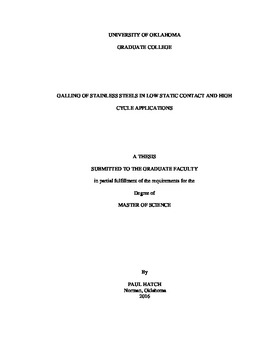| dc.contributor.advisor | Raman, Shivakumar | |
| dc.contributor.author | Hatch, Paul | |
| dc.date.accessioned | 2016-12-09T20:19:45Z | |
| dc.date.available | 2016-12-09T20:19:45Z | |
| dc.date.issued | 2016 | |
| dc.identifier.uri | https://hdl.handle.net/11244/47022 | |
| dc.description.abstract | This study was done to examine the mechanisms involved in the galling of stainless steel surfaces which are subjected to low static contact loads while undergoing a high number of sliding cycles. Presented is a theoretical explanation of why severe adhesion wear may exist in similar applications. The conclusions drawn are based upon other studies as well as the results of physical testing conducted. The testing involved sliding-fit components within a pressure relief valve subjected to high-frequency motion. Flash temperature, surface velocity, oscillatory motion, material properties, and oxide film are theorized to be the causing mechanisms of catastrophic adhesion wear when the normal loading is light. | en_US |
| dc.language | en_US | en_US |
| dc.subject | Galling | en_US |
| dc.subject | Wear | en_US |
| dc.subject | Adhesion | en_US |
| dc.subject | Stainless Steel | en_US |
| dc.subject | Tribology | en_US |
| dc.title | Galling of Stainless Steels in Low Static Contact and High Cycle Applications | en_US |
| dc.contributor.committeeMember | Trafalis, Theodore | |
| dc.contributor.committeeMember | Shehab, Randa | |
| dc.date.manuscript | 2016-12-07 | |
| dc.thesis.degree | Master of Science | en_US |
| ou.group | College of Engineering::School of Industrial and Systems Engineering | en_US |
